The International System: The Global Competition and its Growing Influence on Israel
Oded Eran, Shahar Eilam, Assaf Orion, Eldad Shavit, Arkady Mil-Man, and Tomer Fadlon
The International System: The Global Competition and its Growing Influence on Israel
Oded Eran, Shahar Eilam, Assaf Orion, Eldad Shavit, Arkady Mil-Man, and Tomer Fadlon
Summary chart
Current Situation
Great power competition · Struggle over world order · Technology core issue · Potential escalation (Ukraine, Taiwan) · Less collaboration · Middle East lower priority
Current Israeli Strategy
“Between the raindrops” maneuver · Rely on the US while advancing relations with other powers
Israel’s Strategic Gap
Less room to maneuver between powers · Growing potential in democracy camp · Growing gap between Israel and the West in agendas · Less US regional influence · Intra-US changes challenge support for Israel
Strategic Alternatives
- Full cooperation with the US
- Active partnership in Western camp and adjustments to era of superpower rivalry
- “Between the raindrops”: maneuver without choosing sides
Recommended Strategy
Alternative 2: Strengthen the US strategic mainstay · Stand by the US as a member of the Western camp · Pursue differential foreign policy, adjusted to era of great power competition
Recommended Action
Strengthen special relations with the US: maintain ongoing dialogue on core issues, encourage US regional involvement; preserve bipartisan support; address eroded support for Israel in the US · Great power competition: join Western moves and advance cooperation, especially in science and technology; preserve and delimit relations with China and Russia while narrowing dangers of foreign intervention, influence, and technology transfer · In the region: strengthen regional architecture with help of the West; expand security involvement in the Middle East
Global Overview
Early 2023 is marked principally by the ongoing global recovery efforts from the COVID-19 crisis and the extensive impact of the war in Ukraine, which began with Russia’s invasion in February 2022. The main global formative element remains the competition between the great powers for superiority and influence. This has gradually developed into a struggle over the global order between the two emerging camps – one led by the United States and its partners in Europe and East Asia, and the other led by China with partial support from Russia – with most of the world’s countries not interested in choosing sides at this stage. The struggle is underway simultaneously in many realms: ideology and values (between democracies and autocracies); statesmanship (over the rules of the game in the international system and the global agenda); economy and technology (over natural resources, energy sources, infrastructure, markets and supply chains, innovation and technologies of the future, and access to data); and the military-security sphere.
The rivalry over scientific-technological superiority and over innovation (“the technological arms race”) is at the core of the global strategic competition and is expected to intensify in the coming years. The year 2022 was marked by the global “chip war,” which is gradually joined by competition in other fields – artificial intelligence, quantum computing, biotech, and more – that are seen as technologies that will shape the future of humanity in the coming generations, in both military and civilian uses. Meanwhile, there are ongoing efforts to avoid military escalation and a loss of control at the main points of friction between the great powers, particularly in Ukraine (with the Russian threat to use nuclear weapons, or the possibility of active involvement from NATO) and in Taiwan (potential for military escalation with the involvement of China and the United States).
Against the backdrop of the increasing polarization, the international community is hard pressed to advance global objectives that require broad agreement and joint activity in many fields, in particular, the climate crisis, international trade, food security, energy, refugees, public health, and the proliferation of unconventional weapons. The climate crisis will continue to command center stage in the coming decades, demand broad agreements and collaboration, and also provide fertile ground for competition over resources and control of future technologies. Challenges to internal stability will continue to draw the attention and resources of many regimes throughout the world.
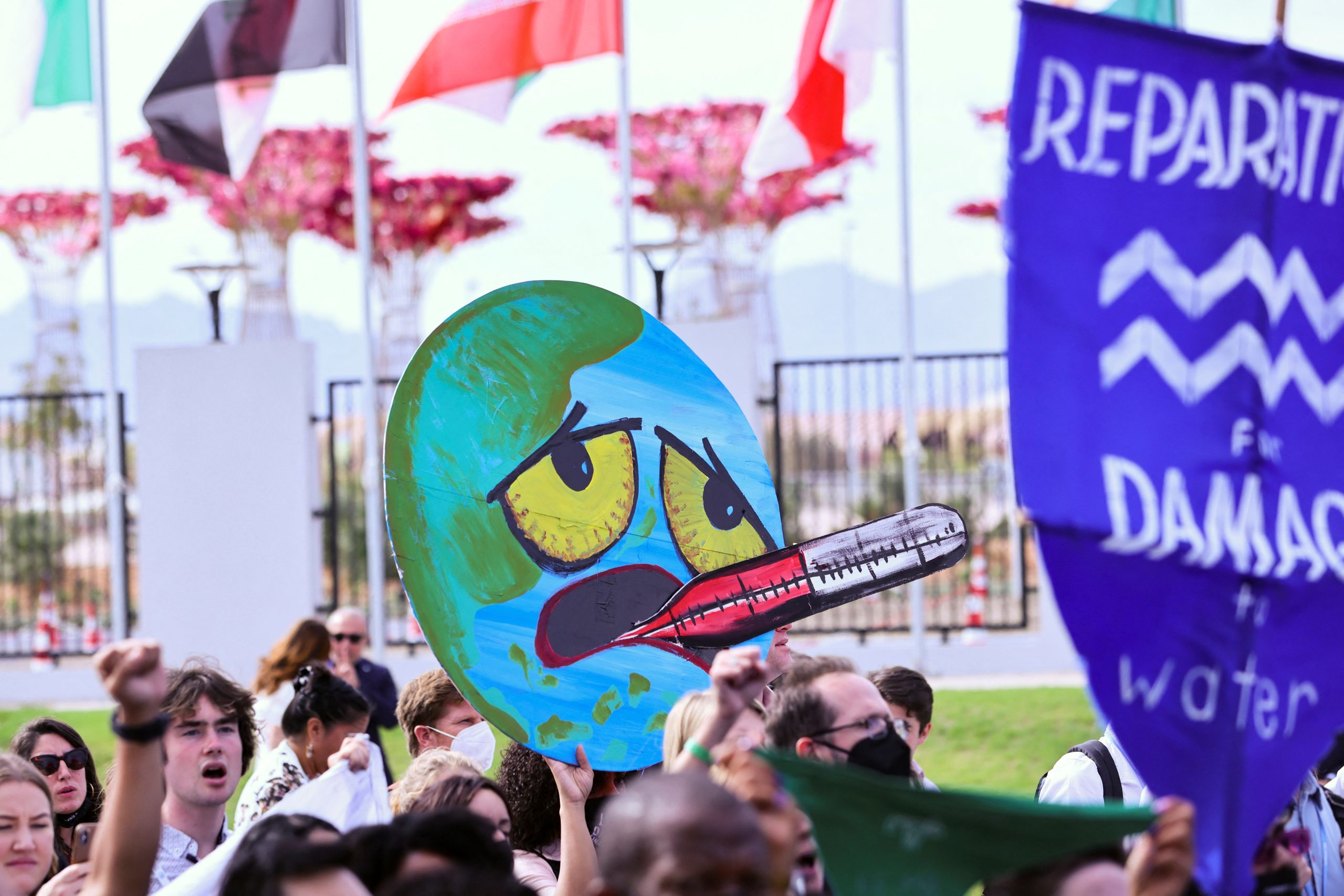
The climate crisis will continue to command center stage in the coming decades. Demonstration at COP 27 in Sharm-el-Sheikh, November 2022
Photo: REUTERS/Mohamed Abd El Ghany
In addition, economic uncertainty will continue. Given the ramifications of the COVID-19 crisis, the war in Ukraine, and the competition between the great powers, the forecasts for 2023 are for an economic slowdown, continued rises in inflation, disruptions to supply chains that accelerate de-globalization trends, and a series of intensifying crises – in the energy market (with serious consequences, especially for Europe), in food security (in the developing world), and in greater numbers of migrants and refugees. Consequently, the economic environment is very difficult to forecast, as can be seen in the economic forecasts of various international organizations (the World Bank, International Monetary Fund, and OECD), which were lowered this year in the wake of the rapidly unfolding developments.
Three main factors are expected to influence the global economy in 2023: the return of inflation, the ongoing war in Ukraine, and increasing governmental involvement in the economy. The disruptions between supply and demand that emerged in the COVID-19 crisis and the ensuing economic policy measures have contributed greatly to the rise in the cost of living throughout the world, and inflationary pressures increased significantly in 2022 due to the war in Ukraine. The impact is especially evident in the rise in energy prices, given Russia’s central role in the oil and gas market, and the rise in food prices, due to both Russia and Ukraine’s contribution to global grain production, including their being the source of a third of global wheat exports. The rise in energy and food prices, alongside the strengthened dollar and the increased debts of developing countries, could lead to political instability, including in Middle East countries that are not energy producers.
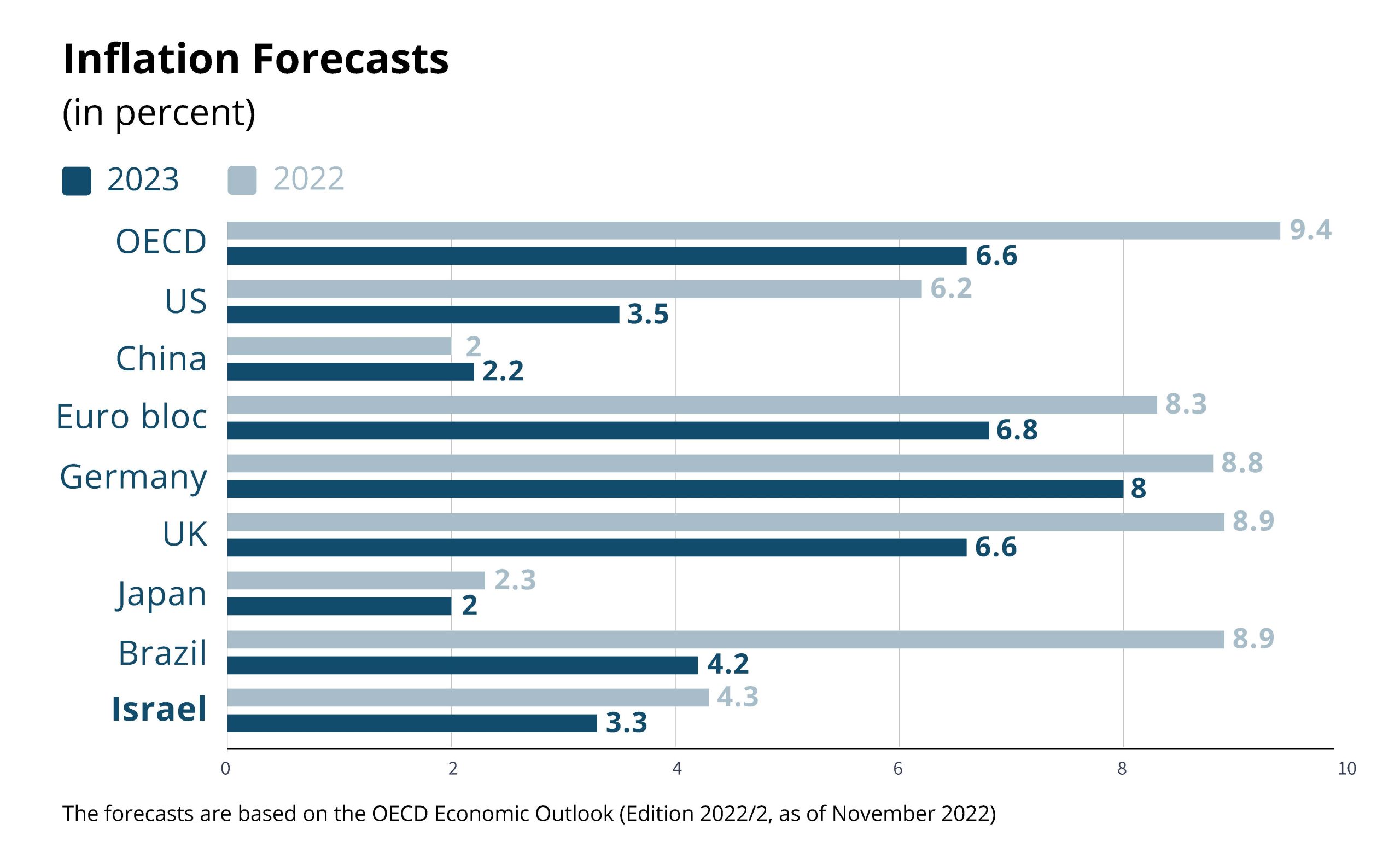
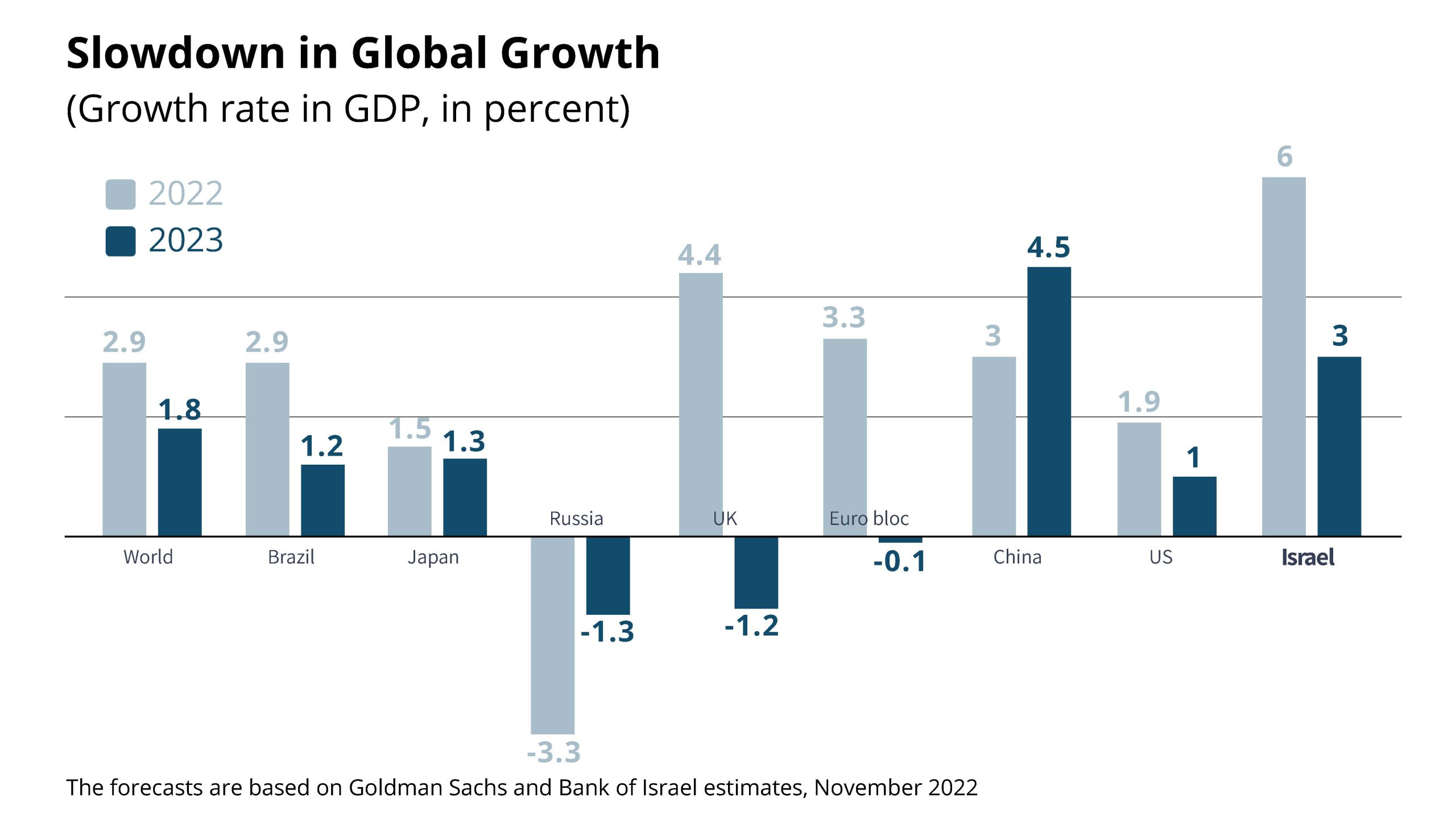
From a geostrategic perspective, the international system is focused first and foremost on Europe, especially given the war in Ukraine, and in the Indo-Pacific region, given China’s increasing strength and the economic, industrial, and technological acceleration of the region’s countries. The Middle East continues to become a lower priority in terms of the attention and resources allocated to it.
The United States will likely continue to focus on its domestic arena, with efforts to improve the economic situation and rebuild infrastructure. However, the administration faces difficulties in advancing its agenda given the social polarization and its more limited political leeway following the midterm elections, when the Republicans won a small majority in the House of Representatives. In the background, the opening shot of the 2024 presidential elections has been fired.
The administration has defined the strategic competition with China and the climate crisis as the two most important issues for shaping the global reality in the coming century. In the eyes of the United States, Russia, despite its reduced importance compared to China, reflects an urgent threat that demands an immediate response to contain it. The US will try to continue to exact prices from Russia without being drawn into war, mindful of the need to prepare for possible escalation.
The administration has also placed scientific and technological innovation and the opportunity of the fourth industrial revolution (which is based on maximizing the use of big data, artificial intelligence, and machine learning) as keys to success in the strategic competition with China. The US will seek to maintain its position as global leader while strengthening its domestic sources of power and resilience, with an emphasis on massive investments to maintain technological superiority and strengthen industrial capabilities, restrictions on the transfer of technology to China, and consolidation of its network of economic and military partnerships with democratic countries and countries that support the existing world order, in order to deter and weaken its rivals.
So far, the United States and China have succeeded in managing the disputes between them with relative caution. For example, on the issue of Taiwan, the United States adheres to its official policy – “one China” – and opposition to unilateral change of the status quo in Taiwan. Nevertheless, the developments in the past year, especially surrounding the visit to Taiwan by then-House of Representatives Speaker Nancy Pelosi, illustrated the risk of escalation due to a miscalculation or what could be seen as a provocation, despite the interest of the two nuclear powers to avoid war between them.
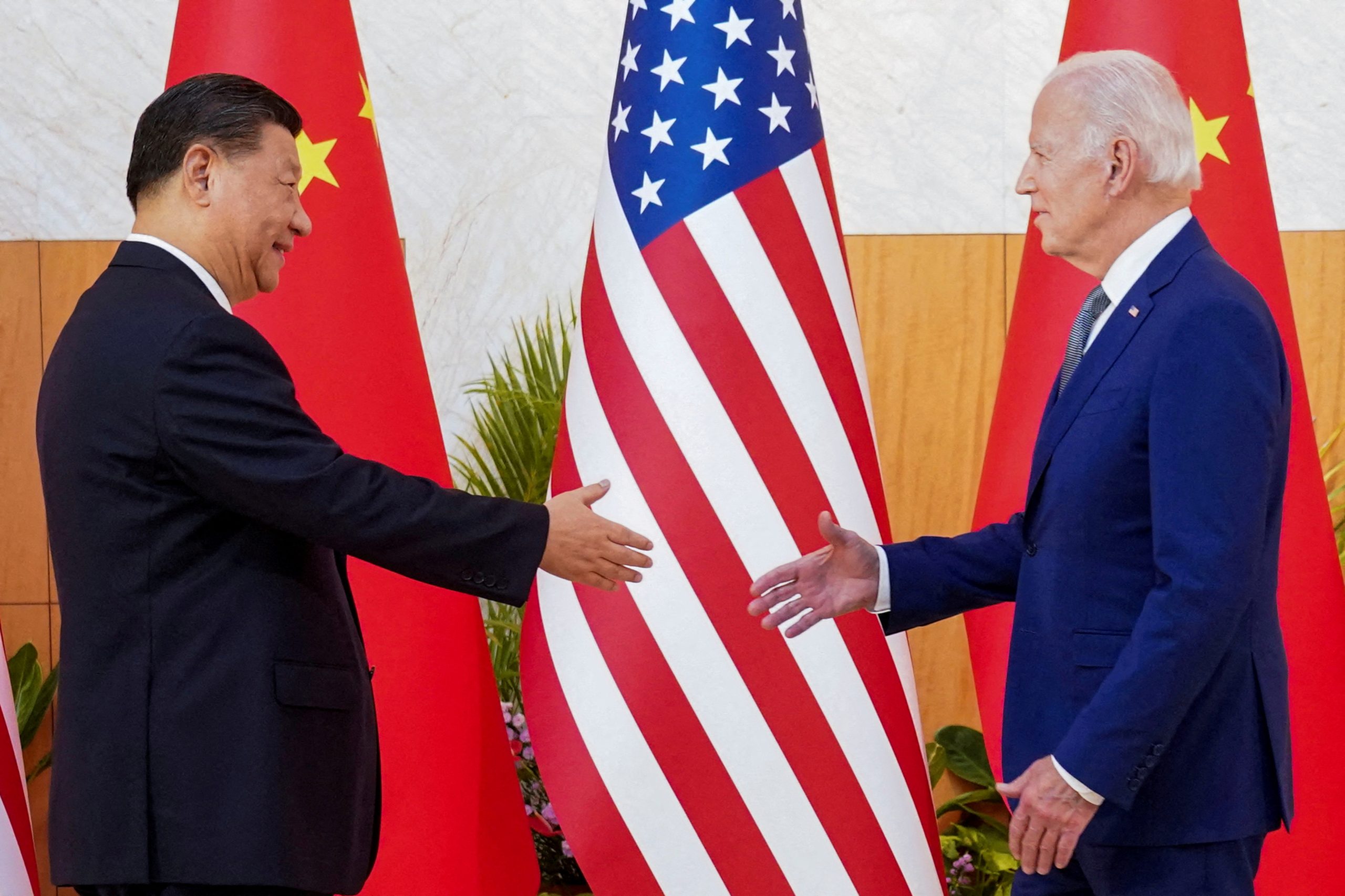
So far, the United States and China have succeeded in managing the disputes between them with relative caution. President Biden and President Xi at the G20 Summit in Indonesia, November 2022
Photo: REUTERS/Kevin Lamarque/File Photo
The balance sheet at the end of 2022 includes achievements for US foreign policy and its efforts to strengthen its regional coalitions in the Indo-Pacific region and Europe in response to the Chinese-Russian challenge. In the Middle East, however, US standing continues to erode against the backdrop of its failure, from the region’s perspective, to block Iran’s nuclear program and its destabilizing activity in the region. The OPEC countries’ refusal to accede to United States requests to increase the production of crude oil given the energy crisis, as well as the summit meetings that China’s President held with leaders of the region’s countries in December 2022, are further evidence that the competition between the great powers will also play out in the Middle East. In countries in Asia and Europe too, which have displayed increased vigilance and a willingness to contend with the Chinese-Russian challenge, there are voices warning against taking the course charted by the United States in the competition between the great powers.
In China, the Communist Party Congress that convened in October 2022 consolidated the standing of Secretary-General and President Xi Jinping as the unchallenged leader of the Party and the country. At the outset of his third term, Xi can now seemingly advance his political-ideological doctrine without interference. However, in practice he faces serious internal and external challenges: in 2022 China’s economy experienced a significant slowdown and stood at half (2.7 percent, according to the World Bank estimate) of the growth target defined by the regime (5.5 percent), including serious crises in the fields of real estate and credit. While the world transitioned to living with COVID-19, China maintained its “zero-COVID” policy until the end of 2022. This policy disrupted economic activity and the daily lives of citizens, and prompted an unusual wave of protests throughout the country and large-scale outbreaks of illness once the policy was rescinded. Moreover, after years of economic expansion based on maximized centralization, efficiency, and the advantage of size in a free world market, China is now coping with countermeasures on the part of many economies in the world in response to what is perceived as its threatening conduct.
Furthermore, relations between China and the United States (and other countries in the West) are at a low point, despite mutual attempts to maintain open channels of communication. Especially prominent is the escalation in the economic rivalry between them, led by the “chip war” and decoupling trends in various fields and sectors. In addition, there also appears to be a gradual acceleration of military preparations on both sides in light of a possible crisis in the Taiwan area. China faces challenges in international frameworks, particularly with regard to violations of civil rights. Despite the support that it receives from many countries, it does not have real allies, and the “no limits friendship” that the leaders of China and Russia declared in their meeting on February 4, 2022 has been tested significantly since the Russian invasion of Ukraine later that month. Meanwhile, more and more countries understand that China poses a direct challenge to them unrelated to the US stance, given its attempts to intervene in their affairs, sometimes to the point of creating dependence and coercion, pursuing espionage and influence, transferring technology, and stealing intellectual property.
Russia’s entanglement in the war in Ukraine and the costs it has incurred signal a weakening of its standing in the global arena (whether the fighting continues in 2023 or whether it is stopped or decided one way or another). At this stage there are no signs of the war ending in the coming months, and therefore Russia’s political and economic detachment from the West is expected to deepen; its economy will continue to be hurt by the sanctions imposed on it and by the difficulties it faces in exporting energy. As a result, Russia will continue to strengthen its relations with its allies in other areas of the world, in particular with China and Iran, and thus its subversive and defiant activity toward the West will continue. The deterioration of Russia’s economy is also expected to feed the social unrest in the country and spur emigration of those wishing and able to leave it.
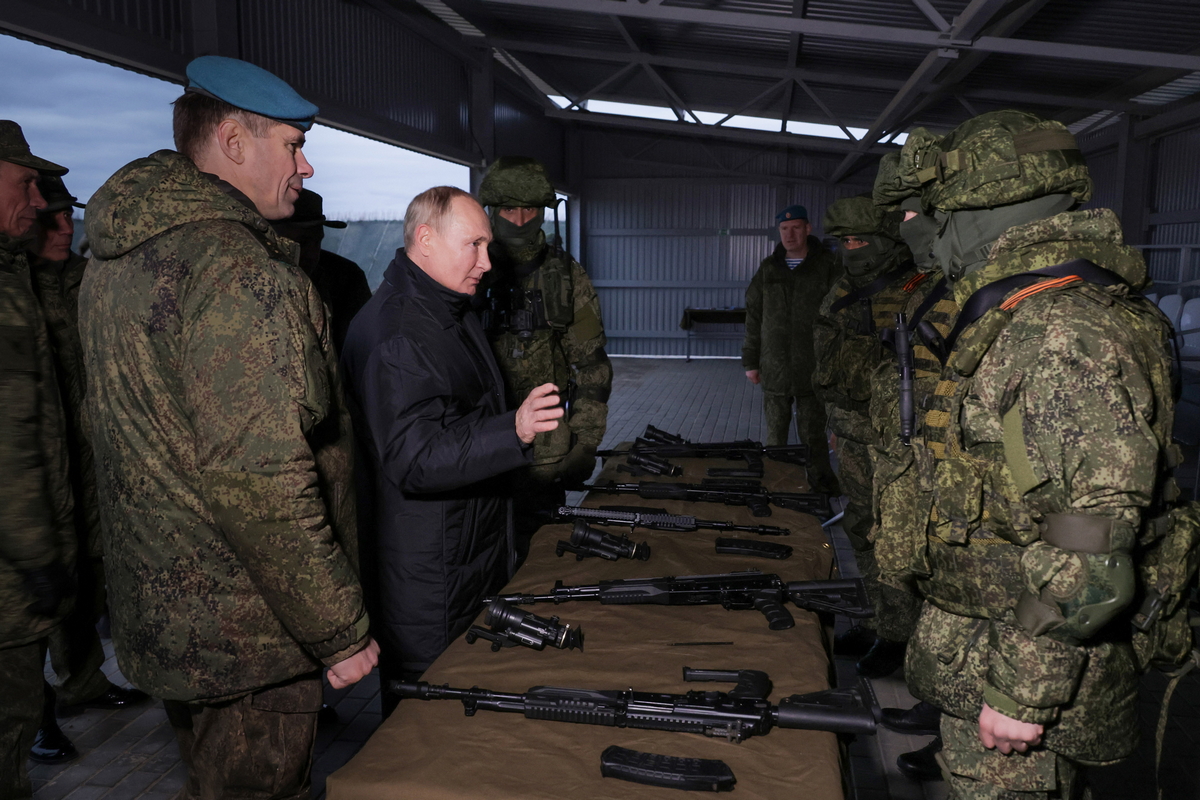
There are no signs of the war in Ukraine ending in the coming months. Russian president Putin visiting a military base in Ryazan region, October 2022
Photo: Russian Defence Ministry/Handout via EYEPRESS
Europe is in turmoil. The Russian invasion of Ukraine revived the bellicose atmosphere on the continent and highlighted anew the Russian threat, the gaps in preparedness and responses to the threat, and the risks inherent in economic dependence on Russian energy sources and supply chains from China. The ongoing war has shifted Europe’s decades-long priority to drive economies over investment in defense. The NATO alliance has reawakened and gained renewed significance, and the defense budgets of European countries have been updated and bolstered. At the same time, Europe is reexamining the risks posed by China and the implications of the strategic competition announced by the United States. Alongside foreign challenges, Europe continues to cope with increasing internal difficulties, especially the worsening of the economic slowdown, the rise in inflation, and the energy supply crisis, as well as the wave of millions of refugees from the war in Ukraine. All these strengthen political parties with an ultra-nationalist platform and elements opposing the European Union.
The Great Powers in the Middle East
While the world is focused on East Asia and the war in Europe, the role of the Middle East on the global agenda continues its slow decline given the gradual transition to alternative energy sources – at least as long as the relative stability in the region is maintained. While the US administration is not planning significant changes to its military presence in the region, it is relying on expanding its influence mainly through diplomatic tools and support for its allies in the region. They, for their part, have identified a decline in the US commitment toward them, given the US hasty withdrawals from Syria and Afghanistan, its reluctance to use military force against those attacking its allies, and the imposition of restrictive conditions (human rights) for cooperation. Given the failure (so far) of the efforts to return to the nuclear agreement with Iran, which has made significant progress in its nuclear program and in weapons proliferation, the administration will have to reassess its policy toward Tehran and try to restore its eroded influence and standing in the region, in part by strengthening its support for advancing the regional architecture of its partners (Iran’s adversaries, including Israel), which includes military elements alongside economic initiatives, the development of infrastructure, and other collaborations. While the administration’s attention toward the Palestinian issue is limited, it has already made its intention clear to pressure the Israeli government to maintain the status quo and avoid deterioration, out of an intention to make it possible in the future to advance a political process based on the two-state principle.
Meanwhile, China has increasing interests in the Middle East, as it is still dependent on importing oil from the region and identifies the regional potential in demand for economic and infrastructural development, against the backdrop of the perceived decline in US influence. Therefore, China will likely continue to expand its economic, political, and gradually also military involvement on both sides of the Iranian-Saudi divide, but without involvement that entails substantive risk. At this stage most countries in the Middle East have not chosen a side, and they seek to make the most of their relations with both the United States (with an emphasis on defense) and China (with an emphasis on the economy). At the same time, some countries that so far have relied on US military-strategic support are reexamining their strategy and displaying a policy of diversifying supporters and hedging risks, although China is not offering security guarantees. For Russia too, the region’s importance is increasing, in light of its growing need to attain trade alternatives, bypass the Western sanctions, and coordinate oil production levels. To this end, it is trying to strengthen its relations with the Gulf countries, Saudi Arabia, Turkey, and Iran, while also tightening its military cooperation with Iran surrounding the fighting in Ukraine. At the same time, Russia is thinning out its military presence in Syria due to the demands of the Ukrainian front, but trying to ensure and strengthen its military presence in the Mediterranean and the Persian Gulf.
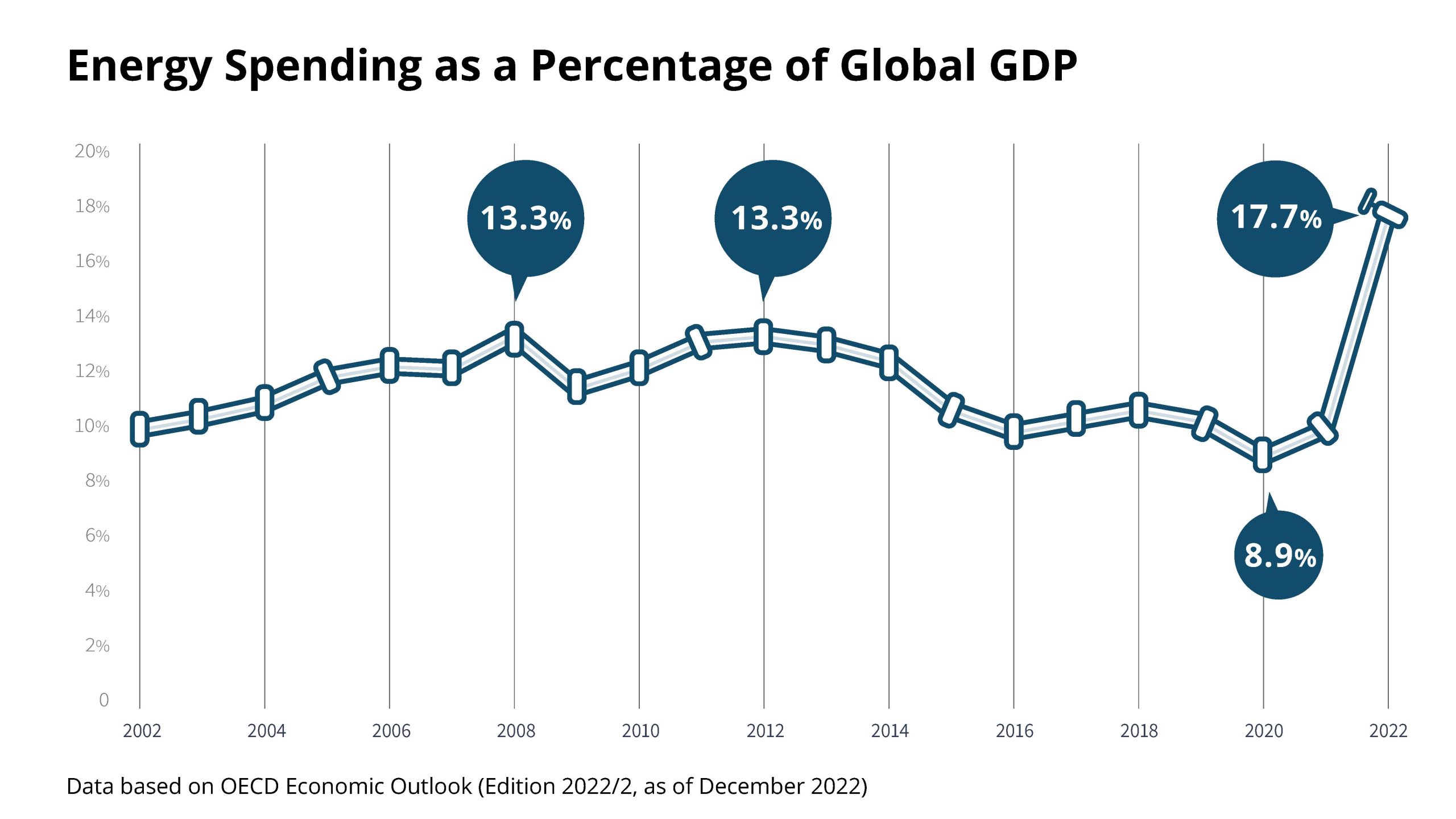
Implications for Israel
As the focus of US national security strategy, China will continue to influence many aspects of the administration’s policy, including vis-à-vis Israel. The United States will continue to pressure its partners to shape policy that takes its interests into account, especially in the context of oversight of technologies and data, national infrastructure, and infrastructure used by China. Consequently, Israel’s leeway on issues that are at the core of the competition and the friction between the great powers is expected to shrink, with an emphasis on advanced technology. Israel is aware of the global changes and has adapted its policy, but given the urgency that China commands as a top priority in American foreign policy (and to a certain extent, Russia as well), it is vital to continue these adaptations and improvements at a suitable pace, and thus to reduce the potential for friction and crises on this issue. Nevertheless, it is important that Israel continue to maintain fruitful economic relations with China, that is, to make the most of the opportunity and the advantages for Israel’s economy, subject to national security considerations and in close coordination with the United States.
Meanwhile, the competition between the great powers also entails an opportunity for increasing Israel’s leeway vis-à-vis the United States camp, for strengthening collaboration, and for equity in areas in which Israel has clear relative advantages – technology and innovation; the development and application of weapons and modes of operation under the threshold of war; and a positive Israeli role in developing regional architecture with the support of the United States and in the Indo-Pacific region.
At this stage it seems that the erosion of United States standing in the region will continue. This is signaled in part by defiance exhibited by senior partners (Saudi Arabia, Turkey) that in turn could hurt its ability to help advance Israel’s objectives in the region and Israel’s overall standing and its deterrence, which partly relies on the image of its special relations with the United States. The most prominent test of deterrence for both the United States and Israel is in deterring Iran from continuing to progress toward nuclear weapons. Its success will spare them the need to meet the test of stopping it.
Despite their solid basis, the special relations between Israel and the United States could be tested, mainly in the context of the Palestinian issue (taking steps that are seen as changing the status quo and violating human rights), charged internal Israeli issues (which could be seen as harming its democratic character and consequently the “shared values”), Israel’s policy on China (technology security), and the Iranian issue (including in the absence of a nuclear agreement between Iran and the great powers). Moreover, the basic gap between the Israeli agenda (Iran, Palestinians, Hezbollah) and the US agenda (China, Russia, and global challenges) is more prominent than in the past, along with a gap between the worldview of the right wing government in Jerusalem and the Democratic administration in Washington. From a long-term perspective, the relations will also be influenced by changes in American society, which are expressed, inter alia, in the strengthening of the critical attitude (to the point of hostility) toward Israel in certain sectors and in an increasing difficulty to maintain bipartisan support for Israel in an era of worsening political polarization in the United States itself.
The new government in Israel should pay special attention to Israel’s relations with the Jewish community in the United States. Due to the social and political changes in Israel and the United States, the cracks and gaps in the relations are expanding, and there is increasing distance between American Jewry and Israel and its regional environment. These are joined by less understanding with Israel and could portend serious negative consequences for Israel-United States relations.
Adjustments in Israel’s Strategy and Policy Recommendations
Along with the Israeli reliance on the United States and further cultivation of its strategic relationship, over the years Israel has often realized the potential to develop channels of contact with other main actors in the international arena: Europe is Israel’s main trade partner (and recently the political dialogue with European Union institutions at the highest level was renewed); in the past decade, Israel’s economic relations with China evolved significantly and accelerated; and ongoing channels of dialogue with Russia were developed. The Abraham Accords created an opening for Israel’s gradual integration in the Middle East fabric as well. Over the years Israel has also made sure to maintain the ability to maneuver between international economic and political institutions and relations with the member states of these institutions.
However, the changes in the international system and especially the strategic competition between the great powers require that Israel monitor the shrinking or expanding areas of activity and adjust its policy accordingly. After a decade of intensive developments in Israel’s economic relations with China, Israel has started to enact a more balanced and sober policy, in which relations with China have advanced but at the same time the oversight of foreign investments has been tightened twice, in particular in the field of infrastructure, and a strategic dialogue with the United States has begun in the field of advanced technologies, which also includes research and technology security. In the past year Israel likewise had to maneuver between relations with Moscow and a public moral stance that condemns the invasion of Ukraine and the ensuing war crimes, and to participate in the West’s efforts to aid Ukraine.
Consequently, it is necessary to adjust Israel’s foreign policy to the era of great power competition:
The Organizing Concept
Strengthen the United States’ role as a strategic mainstay, based on standing with the United States as part of the Western camp, and enact a differential foreign policy per area that is adapted to the era of great power competition.
Policy Guidelines
- Strengthen the special relations with the United States: maintain close and continuous dialogue with the administration on the core issues that are important to both sides (Iran, China and technology, the Palestinians and human rights, regional integration and normalization, Russia, qualitative military edge, and arms control), while coordinating mutual expectations and taking main American interests into account; work to maintain US involvement in the issues fundamental to Israel’s national security; maintain bipartisan support for Israel and persist in efforts to improve relations with the Democratic party, along with strengthening relations with the Jewish communities in the United States; identify long-term challenges that threaten to erode the foundations of the special relations between the two countries and with the younger generation of American Jews, and prepare to cope with them.
- In the context of the inter-bloc struggle – join and enlist in the efforts of the United States and the West in a mindful manner; advance practical collaboration with the United States and the Western camp, in particular in the fields of science and technology, which are central equity and policy tools for Israel; strengthen the interfaces with the Indo-Pacific region and with Europe and Canada; exploit the growing potential for defense exports to Europe; adjust areas of activity in accordance with developments in the great power competition; advance fruitful economic relations and friendship with China, subject to national security considerations; delimit relations with Russia and maintain them in accordance with Israeli interests, especially in the northern arena and given the developments in Ukraine, while reducing exposure to risks of espionage, intervention, and influence.
- In the context of regional policy: strengthen the emerging regional architecture with the support of the United States and the West – politically, militarily, and economically (energy, water, food security, climate, and environment); expand military involvement in the Middle East in order to increase Israel’s equity; and bear the shared security burden alongside the United States and regional partners, given suitable military buildup.
All the researchers from the INSS international research programs helped formulate this assessment.


